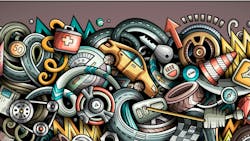Technology continues to drive innovation in the automotive space with more advanced electrical systems and sensors. Therefore, the tools that repair and maintain those cars must also advance. Quick lube shops as well as those that offer a few more services need methods to learn about new tools, determine how necessary they are, and gain skills to put them to use.
This can require attending seminars and meetings at trade shows and industry events, reading industry publications, continued learning with in-person or online classes, and developing a community of shops whether it is in your market or shops in other regions. An allegiance to a brand of tool can offer opportunities to work with reps to further learn about the latest offerings.
A combination approach may be what's best for discovery and education to help keep up with advancing technologies and needs.
Technology and Specialized Tools
The automobile has gone through changes from being more mechanical to more electronic. While shops and technicians are able to keep up with advances in technology, the at-home mechanic might not be able to keep up with the technology and especially the multitude of specialized tools required for maintenance.
"There are so many specialized tools," says Dave Matson, owner of Twin City Tire & Service and Twin City Tire Express in Brewer, Maine. "There's a reason people are here now rather than at home doing the work on their own."
While shops have incentive to look for job-specific tools that will make working on cars easier, faster, and more efficient, it still takes effort to find those new tools as they come out. Matson tells NOLN that he attends trade shows and conferences and delves into industry publications while he works with sales reps, and culls feedback from a network of colleagues from shops in his market.
It takes all these activities—and likely more—just to stay on top of technology, service trends, and tools to improve efficiency in his shops. He also listens to the feedback from employees at his two shops for their expertise.
"Many in my support staff (have) been in this business longer than me," states the industry veteran, who has been in the business for 25 years.
Matson employs ASE master technicians at both facilities.
Universal Tools Help with Efficiencies
There is the long-held belief that you need to have the right tool for the job, and that is certainly true today when many tools are increasingly task-specific.
Yet, this doesn't necessarily mean that a large investment is required, or that it will result in a full tool bench of new gizmos and gadgets. Many tools have a base unit that accepts attachments—much like a drill—that can make the purchase of new tools somewhat easier to handle. One example of a tool system is the M18 Fuel line from Milwaukee Tool, where many of the accessories work on the same system and are forwards and backwards compatible, which helps upgrades to go more smoothly.
"It starts and ends with the end user," Milwaukee Tool Senior Product Manager Ryan Mack details to NOLN. Development starts with "spending time in the shop, understanding the process, workflow of the shop. What are the technicians trying to achieve?"
Milwaukee Tool offers trade-focused solutions for professionals with products that drive productivity in the shop. User feedback drives development of new tools to help advance traditional processes and introduce innovative changes such as using a high torque impact wrench to change tires.
The impact wrench helps drive productivity in a number of ways. The tool is designed to speed up tire changes in the shop by minimizing application time.
"There is a general-purpose solution available, the impact wrench. This is designed specifically for tire changes," says Mack. "To change the way users are changing tires, reducing the time it takes."
Mack suggests that tool acquisition falls into three categories: productivity, safety, cost.
"Time is money in every shop," says Mack. "If you can save somebody five seconds, that starts to stack up to a savings over time."
Productivity and cost go hand-in-hand, as improved productivity equates to cost savings per user.
Further, tools that increase safety minimize hazards in the shop and help employees maintain a safer work environment. Considering productivity, safety, and cost helps in the decision on whether to acquire a new tool, and how it will fit into shop operations.
It is also helpful to consider whether a tool will be useful in the shop or sit in the toolbox waiting for that same task to come up again.
Matson says he discusses tool acquisitions with his service and sales staff to determine how often a service task will occur. "Is this something that is going to become more frequent, or is this a one-off?"
It might be possible to get around the one-off service requests without a specialized tool. If the same jobs come into the bays more often, it will help with efficiency to have more specialized tools, and the purchase will pay off for the shop.
Build a Network of Colleagues
Word-of-mouth is often the best way to choose a tool or hear about a technique you can put into action in your shop. Seek out other shops in your market as well as from other areas to regularly discuss what is going on in the shop, what new tools you've added, and other experiences that can help each other.
When it comes to tools, "I often ask for representation. If somebody else has implemented a specific tool in their business, I will just call them and ask about it," explains Matson.
The Brewer, Maine, shop owner offers the same consideration to colleagues who contact his shop. "We've helped multiple shops in our area both get off the ground and improve their processes and techniques," he says. "We’re always here to help lend a hand to fellow owners of shops. I'm a firm believer that there's plenty of business out there, and we would rather work with local shops in the area than try to work against them."
This network of colleagues helps Matson—and other shops—stay on top of new tools and technologies coming out.
"I consider ourselves leading edge, but we're never the first to do anything," Matson explains. "We reach out and ask (other shop owners) for a few minutes of time and get a real-world review from a user. We get some professional input."
About the Author

Enid Burns
Enid Burns is a writer and editor living in Grosse Pointe, Michigan, and is a freelance contributor to NOLN. She has covered a wide range of topics from video games and consumer electronics to online advertising and business. When living in Manhattan for 20 years she did not own a car, and is often mistaken for that woman who brings her car to the shop and knows nothing. She has learned a great deal from writing for NOLN, but also learns from those shop owners who try to educate her on their services. Enid is a news junkie who spends evenings streaming TV shows and time off on long walks, bike rides, and fiber arts.
